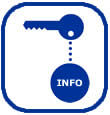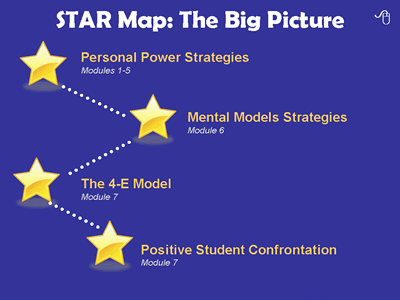 Self Responsibility Tools
Self Responsibility Tools
Click on the map to view the STAR Map of strategies for this course (page will open in a new window).
PERSONAL POWER STRATEGIES
(Modules Three through Five)
- PPS 1: Provide Choices
- PPS 2: Personalize Choices
- PPS 3: Choose, Pick, Decide
- PPS 4: Freedom Phrases
- PPS 5: Stretch, Risk, Challenge
- PPS 6: STAR Technique
- Stop
- Think
- Act
- Review
- PPS 7:Attribute Awareness Activities
- Attributes List
- Control Factors
- I Forgot
- Cause and Effect Diagram
- Project Map
- To What Do You Attribute That?
- Situation Grid
- PPS 8: I Can’t Antidotes
- PPS 9:Mind Skills
- Look for the Doughnut
- Focus/Unfocus
- Cosmic Time
- Shake It Off
- Turn Down the Volume
- Flush It
- Turn the Page
- Positive Self-Talk
- Turnaround Statements
- The “Be” Choice
- Own It
- PPS 10: Problem-Return Technique
- Step 1: Deliver Empathy and Ownership Statements.
- Step 2: Ask an Idea Question.
- Step 3: Get Permission to Suggest Alternatives.
- Step No. 4: Give Alternatives.
- Step 5: Analyze Alternatives (optional).
- Step 6: Deliver a Response-Ability Statement.
- Step 7: Deliver a Brief Power/Victim Lectureburst.
- Step 8: Exit
- PPS 11: Solution-Seeking Process
- Step 1: Have a Need for a Solution
- Step 2: Check Perceptions
- Step 3: State the Problem
- Step 4: List Solutions
- Step 5: Reach Consensus
- Step 6: Make a Commitment
- Step 7: Set Date to Reevaluate
- Step 8: Repeat the Process (if necessary)
MENTAL MODELS STRATEGIES
(Module Six)
MM Strategy 1: How to do things in class
1.a – Divide and Limit Information
1.b – Be Consistent
1.c – Check on Students Soon and Often
1.d – Be Redundant
1.e – Create Structure
1.f – Demonstrate Patterns
MM Strategy 2: Make expectations clear & simple
2.a – Use “Teacher Talk” Strategy ”Next Time”
2.b – See One, Do One, Teach One
2.c – Hold Students Accountable
3.a – Help Students set Goals
3.b – Develop Internal Standards
MM Strategy 4: Give constructive examples of how students can improve
4.a – Help Students get Organized
4.b – Provide Role Models: Mentor and Mentee
4.c – Use Self-Referred Comments
THE 4-E MODEL
(Module 7)
- Educate
- Direct Teaching
- Build a T-Chart
- Red Light/Green Light
- Curriculum/Stories
- Modeling
- Experience
- Examine/Evaluate
- Forced Choice
- Continuum
- Fill in the Blank
- Specific to Individuals
- Open Ended
- List
- Questions
- Enforce the Consequences
POSITIVE STUDENT CONFRONTATION
(Module 8)- Prepare
- Open the Meeting
- State Three-Part Confrontation Message
- Discuss and Handle Defensiveness
- Agree on a Solution and Close
- Follow-Up
More Key Information

